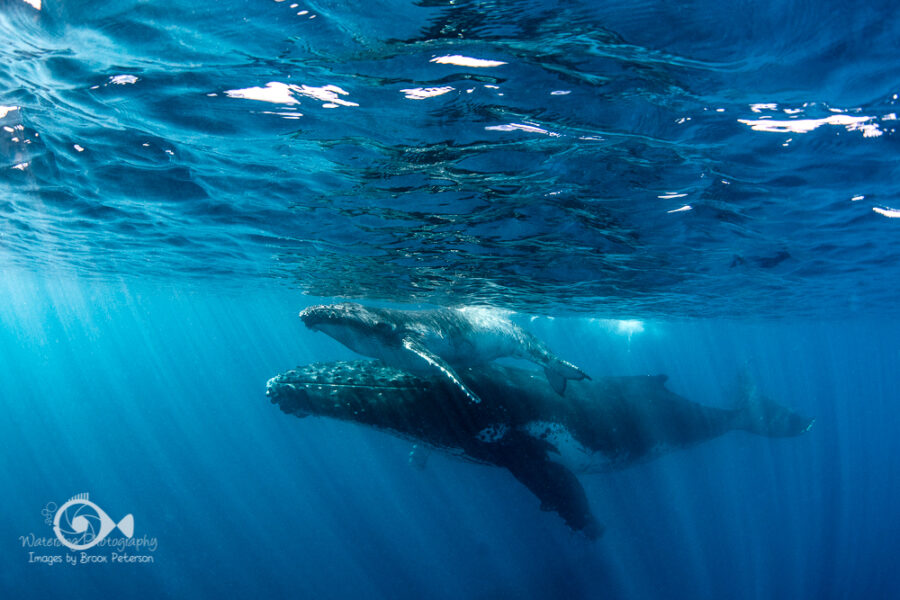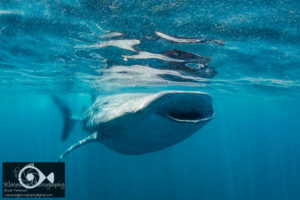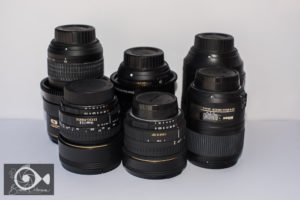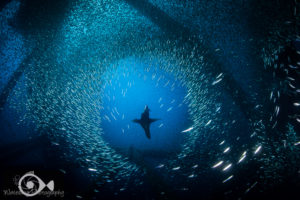
An adult Humpback Whale breaches out of the water
I live in California, and humpback whales migrate through our coastal waters every year. I have been whale watching and seen the magnificent beasts on many occasions. But past experience would not prepare me for the encounters I was to have in Tonga. Watching whales from a boat at no closer than 100 yards is nothing like being in the water with whales just a few feet away. The whales that migrate along the California coast to Alaska are still threatened, although most populations of humpback whales are no longer listed as endangered. For this reason, it is illegal for humans to interact directly with Northern Pacific humpback whales.
But Tonga is a different story. The Southern humpback whales migrate down to Antarctica and are no longer listed as endangered, although their populations are nowhere near what they once were. It is possible to travel by day boat and get in the water with humpback whales, or the liveaboard, Nai’a, spends six weeks of the year in Tonga for whale excursions. The options are limited, which makes this trip even more spectacular. There are only about 100 guests a year on the Nai’a who get to spend time under water with humpback whales.

Sunrise near a small island where the Nai’a was anchored for the night
Each day starts out already anchored near prime spots for seeing whales. On several occasions, we were out in the water early in the morning. One morning we followed a mother humpback whale and her baby for about an hour. The baby breached over, and over again, playing in the waves and splashing its tail and long pectoral fins. It’s mother also breached a few times, and they were escorted by another adult whale who took a turn or two breaching as well. It was very stimulating action, but soon the baby tired and the three whales settled down to rest. At this point, we were able to get in the water with them. If the whales were calm and interested in us, they would stay around and watch us watch them. Sometimes, they didn’t want our company and they would leave.

A humpback whale breaches completely out of the water
On this day, the baby seemed to wear out and settled down to rest. Its mother hovered near the top of the water where she could easily breath. Baby whales cannot hold their breath very long and they are too buoyant to hold themselves down under water without swimming. They will get a breath of air, then swim down under their mother’s chin where she will hold them down until they need to come up for air again. It is an interesting encounter because the mother may stay at a depth of 100 feet or so, or just under the surface. This mother seemed to be napping at the surface, and the baby was resting as well. The adult escort slowly circled the pair from below. None of the three seemed at all bothered that four humans were there watching and photographing them.

A mother humpback whale and her calf asleep
The whales spend several months in Tonga, where the water is warmer, to breed, give birth and teach their young to survive. They migrate yearly down to Antarctica to feed on the abundant krill. The trip is dangerous for the young whales as they are hunted by Orcas along the way. Mother whales will sometimes hold their babies on their nose or backs to help protect them from the hunters. We witnessed them practicing this behavior on several occasions.

A female whale pushes her calf over her head and is escorted by another adult whale
Sometimes we had encounters where a baby whale was particularly playful and interested in us. This baby would splash around on the surface, then come over to us for a closer look. It seemed curious about us, but never strayed too far from its mother.

A young humpback whale plays on the surface
The whales are also in Tonga to breed which means there are many frisky males around. On several afternoons, the males would form a pack and aggressively swim, snort, breach and slap their fins on the surface. This is called a bull run and it is exciting. One afternoon a pack took interest in the Nai’a and spent several hours circling and performing for us. One whale turned over on its back and swam just under the surface right along the side of the boat. It was breathtaking.

A whale flies by under water with its underbelly facing the sun like an airplane

Five or six male humpback whales aggressively swim in the water in an attempt to establish an alpha for mating
Humpback whales are very intelligent, and they have excellent eyesight. They will bring their nose up out of the water until their eye is above the surface to look around at what is above the water line. This is called a “spyhop.” We saw this behavior in adults mostly, but the babies also tried it.

The most beautiful thing about traveling to Tonga to photograph the humpback whales was learning about their behavior. They have a social structure in which they protect each other. Their young are cared for by the mother and often an additional escort. The mothers have a sweet relationship with their babies where they seem to gently teach them how to be a whale. One of the most astonishing things about the babies is how at two tons, they are still playful as puppies and their behavior reflects their light-heartedness. It was easy to fall in love with them.
In the end, I found that watching the whales from the surface was just as satisfying as watching them beneath the surface. They are truly a species that enjoys both realms which is something I have in common with them.

Humpback Whale Fluke






